Research on Key Roof-Cutting Parameters for Surrounding Rock Stability Control in Gob-Side Entry Retention without Coal Pillars in Karst Mountainous Area
Abstract
Featured Application
Abstract
1. Introduction
2. Engineering Background
2.1. Geological Overview
2.2. The Effect of GSER
2.3. Analysis of Key Factors Affecting the Stability of Surrounding Rock in GSER with Roof Cutting
3. Mechanical Analysis of Stress Optimization Induced by Roof Structure in GSER
3.1. Mechanical Model Construction
3.2. Analysis of Mechanical Model Results
4. Simulation Analysis of Key Roof-Cutting Parameters for GSER
4.1. Simulation Scheme and Model Construction
4.2. Analysis of Simulation Results
5. Engineering Practice
5.1. Field Monitoring Plan
5.2. Analysis of Monitoring Results
6. Conclusions
- (1)
- The clarification of the gob-side entry retention and roof-cutting parameters under typical geological conditions in karst mountainous areas is crucial for the stability of the surrounding rock. Based on this, by integrating the variation characteristics of coal seam burial depth and the non-uniform load distribution state of the roof in karst mountainous areas, a mechanical model of the cantilever beam structure for gob-side entry retention and roof cutting is constructed. By introducing the theory of limit equilibrium, the superposition principle, and fracture line theory, the differentiated stress distribution of the roof caused by coal seam burial depth is correlated with the parameters of roof-cutting height and angle. Taking the geological conditions of Anshun Coal Mine as an example, by substituting relevant parameters and comparing the increments of tensile stress under burial depth intervals of 50 m, roof-cutting height intervals of 1 m, and roof-cutting angle intervals of 5°, it is found that the influence of roof-cutting height > the influence of roof-cutting angle > the influence of coal seam burial depth. Considering the impact of the correlation among the three factors on the long-term stability of gob-side entry retention, it is necessary to select appropriate roof-cutting parameters in different coal seam burial depth areas to avoid insufficient or excessive roof-cutting issues.
- (2)
- Taking the tensile strength of 7.2 MPa of the main roof as the threshold, the critical values and reasonable ranges of roof-cutting height and roof-cutting angle under different burial depths are provided. The reasonable range of roof-cutting parameters exhibits a fan-shaped distribution feature. As the coal seam burial depth increases, the fan-shaped zone of reasonable roof-cutting parameters gradually decreases. As the roof-cutting height increases, the selectable range of roof-cutting angles gradually increases. Based on the geological conditions of Anshun Coal Mine, it is concluded that effective roof cutting cannot be achieved when the roof-cutting height is less than 4.5 m. When the roof-cutting height is between 4.5 and 8 m, the selectable range of roof-cutting angles is between 0 and 28.5°.
- (3)
- Through three-dimensional numerical simulation analysis, the displacement and stress evolution characteristics of the surrounding rock of the retained roadway under different roof-cutting parameter schemes within a reasonable range were explored. It was found that a smaller cutting angle results in greater sliding resistance between the cuts, leading to larger displacement and stress on the retained roadway roof. Conversely, a larger cutting angle prolongs the drilling cycle, impacting the progress of underground construction. Analyzing the safety factor of the roadway using the strength reduction method, it was observed that within the same burial depth range, as the cutting height and cutting angle increase, the safety factor of the roadway gradually increases, but the rate of increase gradually decreases. Therefore, when determining the roof-cutting parameters, it is essential to comprehensively consider the balance between drilling construction costs and roadway stability. Overall, a cutting angle of 10° is considered reasonable. Furthermore, corresponding roof-cutting height schemes of 6 m, 7 m, and 8 m were proposed for burial depths of less than 400 m, between 400 m and 500 m, and greater than 500 m, respectively. The roadway stability coefficients under these three schemes are higher than those of other schemes within the same burial depth range, with values of 2.02, 1.96, and 1.88, respectively.
- (4)
- Industrial practice was conducted in a typical section of Anshun Coal Mine, and the effect of the retained roadway was verified in terms of the roof displacement, the stress state of the anchor cables on the cutting side, the integrity of the roof surrounding rock, and the deformation characteristics of the support structures in different buried depth sections of the GSER. It was concluded that all three roof-cutting schemes could effectively ensure the stability of the surrounding rock in the retained roadway, thus verifying the rationality of the previous theoretical calculations, numerical analysis, and roof-cutting schemes.
Author Contributions
Funding
Institutional Review Board Statement
Informed Consent Statement
Data Availability Statement
Conflicts of Interest
References
- Gabrovšek, F.; Knez, M.; Kogovšek, J.; Mihevc, A.; Mulec, J.; Perne, M.; Petrič, M.; Pipan, T.; Prelovšek, M.; Slabe, T.; et al. Development challenges in karst regions: Sustainable land use planning in the karst of Slovenia. Carbonates Evaporites 2011, 26, 365–380. [Google Scholar] [CrossRef]
- Babets, D.; Sdvyzhkova, O.; Hapieiev, S.; Shashenko, O.; Prykhodchenko, V. Multifactorial analysis of a gateroad stability at goaf interface during longwall coal mining-A case study. Min. Miner. Depos. 2023, 17, 9–19. [Google Scholar] [CrossRef]
- Malkowski, P.; Ostrowsk, L. Convergence monitoring as a basis for numerical analysis of changes of rock-mass quality and hoek-brown failure criterion parameters due to longwall excavation. Arch. Min. Sci. Arch. Min. Sci. 2023, 64, 93–118. [Google Scholar] [CrossRef]
- Hou, C.; Li, X. The stability principle of large and small structures of surrounding rock in gob-side entry driving for fully mechanized top coal caving mining. J. China Coal Soc. 2001, 1, 1–7. [Google Scholar] [CrossRef]
- Zhang, Y.; Cui, B.; Wang, Y.; Zhang, S.; Feng, G.; Zhang, Z. Evolution Law of Shallow Water in Multi-Face Mining Based on Partition Characteristics of Catastrophe Theory. Fractal Fract. 2023, 7, 779. [Google Scholar] [CrossRef]
- Zhang, D.; Ma, L.; Feng, G. The technology of gob-side entry retention with in-situ backfilling in fully mechanized top-coal caving mining roadways. Chin. J. Rock Mech. Eng. 2005, 7, 1164–1168. [Google Scholar] [CrossRef]
- He, M.; Gao, Y.; Yang, J. Research on the Technology of Spontaneous Roadway Formation without Coal Pillars Using Energy-Concentrated Slotting and Its Impact on the Evolution of Surrounding Rock Stress. Chin. J. Rock Mech. Eng. 2017, 36, 1314–1325. [Google Scholar] [CrossRef]
- Smoliński, A.; Malashkevych, D.; Petlovanyi, M.; Rysbekov, K.; Lozynskyi, V.; Sai, K. Research into Impact of Leaving Waste Rocks in the Mined-Out Space on the Geomechanical State of the Rock Mass Surrounding the Longwall Face. Energies 2022, 15, 9522. [Google Scholar] [CrossRef]
- Malashkevych, D.; Petlovanyi, M.; Sai, K.; Zubko, S. Research into the coal quality with a new selective mining technology of the waste rock accumulation in the mined-out area. Min. Miner. Depos. 2022, 16, 103–114. [Google Scholar] [CrossRef]
- Gao, H.; Gao, Y.; Wang, J.; Fu, Q.; Qiao, B.; Wei, X.; Zhang, X. Study on Bidirectional Blasting Technology for Composite Sandstone Roof in Gob-Side Entry-Retaining Mining Method. Appl. Sci. 2021, 11, 7524. [Google Scholar] [CrossRef]
- He, M.; Zhu, G.; Guo, Z. Longwall mining “cutting cantilever beam theory” and 110 mining method in China—The third mining science innovation. Chin. J. Rock Mech. Geotech. Eng. 2015, 5, 10. [Google Scholar] [CrossRef]
- Yang, J.; He, M.; Cao, C. Design principles and key technologies of gob side entry retaining by roof pre-fracturing. Tunn. Undergr. Space Technol. 2019, 90, 309–318. [Google Scholar] [CrossRef]
- Ma, Z.; Zhang, D.; Cao, Y. Study of Key Technology of Gob-Side Entry Retention in a High Gas Outburst Coal Seam in the Karst Mountain Area. Energies 2022, 15, 4161. [Google Scholar] [CrossRef]
- Hu, J.; He, M.; Wang, J. Key Parameters of Roof Cutting of Gob-Side Entry Retaining in a Deep Inclined Thick Coal Seam with Hard Roof. Energies 2019, 12, 934. [Google Scholar] [CrossRef]
- Boothukuri, V.; Bhattacharjee, R.; Panigrahi, D.; Benerjee, G. Impact of geo technical factors on strata behavior in longwall panels of Godavari Valley coal field-a case study. Int. J. Min. Sci. Technol. 2019, 29, 7. [Google Scholar] [CrossRef]
- Liu, Z.; Ma, Z.; Kazanin, O.I.; Gong, P.; Li, Y.; Ni, X. Deformation Control Technology of Gob-Side Entry Retaining with Large Volume CFST Roadway Side Support in Top-Coal Caving Longwall and Stability Analysis: A Case Study. Appl. Sci. 2023, 13, 8610. [Google Scholar] [CrossRef]
- Gong, S.; Tan, Y.; Liu, Y. Application of Presplitting Blasting Technology in Surrounding Rock Control of Gob-Side Entry Retaining with Hard Roof: A Case Study. Adv. Mater. Sci. Eng. 2021, 2021, 1318975. [Google Scholar] [CrossRef]
- Qian, M.; Miao, X. Analysis of the Key Blocks in the “Masonry Beam” Structure of the Mining Stope. J. China Coal Soc. 1994, 19, 557–563. [Google Scholar]
- Wang, H. Research on Creep Characteristics and Stability Control Technology of Narrow Side of Gob-side Entry. Ph.D. Dissertation, China University of Mining and Technology, Xuzhou, China, 2011. [Google Scholar]
- Zhang, D.; Miao, X.; Mao, X. Simulation Analysis of Roof Movement Patterns in Gob-side Entry Retention with Fully-Mechanized Top-Coal Caving. J. Chin. Univ. Min. Technol. 2001, 03, 47–50. [Google Scholar] [CrossRef]
- Zhang, S.; Zhang, D.; Feng, G.; Chi, M. Modelling method of heterogeneous rock mass and DEM investigation of seepage characteristics. Géoméch. Geophys. Geo-Energy Geo-Resour. 2024, 10, 24. [Google Scholar] [CrossRef]
- Arasteh, H.; Esmaeili, K.; Saeedi, G.; Farsangi, M.A.E. Discontinuous Modeling of Roof Strata Caving in a Mechanized Longwall Mine in Tabas Coal Mine. Int. J. Geomech. 2022, 5, 22. [Google Scholar] [CrossRef]
- Guo, Z.; Wang, H.; Ma, Z. Research on the Transmission of Stresses by Roof Cutting near Gob Rocks. Energies 2001, 14, 1237. [Google Scholar] [CrossRef]
- Zhang, X.; Cheng, L.; Gao, Y. Study of An Innovative Approach of Roof Presplitting for Gob-Side Entry Retaining in Longwall Coal Mining. Energies 2019, 12, 3316. [Google Scholar] [CrossRef]
- Chen, S.; He, M.; Wang, H. Collaborative Control of Surrounding Rock and Stress Evolution Law in Gob-side Entry Retaining with Roof Cutting in Deep Wells. J. Min. Geol. Saf. Eng. 2019, 36, 660–669. [Google Scholar] [CrossRef]
- Zhang, N.; Han, C.; Kan, J. Theory and Practice of Surrounding Rock Control in Gob-Side Entry Retaining. J. China Coal Soc. 2014, 39, 1635–1641. [Google Scholar] [CrossRef]
- Darvishi, A.; Ataei, M.; Rafiee, R. Investigating the effect of simultaneous extraction of two longwall panels on a maingate gateroad stability using numerical modeling. Int. J. Rock Mech. Min. Sci. Géoméch. Abstr. 2020, 126, 104172. [Google Scholar] [CrossRef]
- Zhu, D.; Yu, B.; Wang, D.; Zhang, Y. Fusion of finite element and machine learning methods to predict rock shear strength parameters. J. Geophys. Eng. 2024, 21, 1183–1193. [Google Scholar] [CrossRef]
- Yadav, A.; Islavath, S. Numerical Investigation for Estimation of Behaviour of Barrier Pillars, Gateroads and Face of a Deep Longwall Mine: A Case Study. Mining Met. Explor. 2024, 41, 463–478. [Google Scholar] [CrossRef]
- Verma, A.; Deb, D. longwall face stability index for estimation of chock-shield pressure and face convergence. Geotech. Geol. Eng. 2010, 28, 431–445. [Google Scholar] [CrossRef]
- Esterhuizen, G.S.; Gearhart, D.F.; Klemetti, T.; Dougherty, H.; van Dyke, M. Analysis of gateroad stability at two longwall mines based on field monitoring results and numerical model analysis. Int. J. Min. Sci. Technol. 2019, 29, 35–43. [Google Scholar] [CrossRef]
- He, M.; Chen, S.; Guo, Z. Structural Control of Surrounding Rock in Gob-Side Entry Retaining through Roof Cutting and Pressure Relief and Its Engineering Application. J. Chin. Univ. Min. Technol. 2017, 46, 959–969. [Google Scholar] [CrossRef]
- Wang, Y.; Gao, Y.; Wang, Y. Roof Deformation Characteristics and Preventive Techniques Using a Novel Non-Pillar Mining Method of Gob-Side Entry Retaining by Roof Cutting. Energies 2018, 11, 627. [Google Scholar] [CrossRef]
- Wang, Y.; He, M.; Yang, J. Structural Characteristics and Deformation Calculation Analysis of the “Short-Arm Beam” Structure in the Formation of Self-Forming Roadway without Coal Pillar. J. Chin. Univ. Min. Technol. 2019, 48, 718–726. [Google Scholar] [CrossRef]
- Xu, X.; He, F.; Lv, K. Reasonable roof cutting parameters for roadway retention with thick and hard roof cutting. J. China Coal Soc. 2023, 48, 3048–3059. [Google Scholar] [CrossRef]
- Xu, L.; Li, M.; Guo, L. Key Parameters and Engineering Applications of Pressure Relief and Gob-Side Entry Driving in Close Proximity to the Key Stratum. J. Min. Geol. Saf. Eng. 2023, 40, 91–100. [Google Scholar] [CrossRef]
- Zhang, W.; He, M.; Wang, J. Surrounding Rock Control Technology for Self-Forming Roadway with Ultra-Thick High-Level Roof Cutting. J. Min. Geol. Saf. Eng. 2024, 41, 677. [Google Scholar] [CrossRef]
- Yang, J.; Min, T.; Wang, Y. Mechanism and Design Method of Dynamic Pressure Bearing and Support for Roadway Formation without Coal Pillar. J. Chin. Univ. Min. Technol. 2023, 52, 457–465. [Google Scholar] [CrossRef]
- Yang, J.; Wang, H.; Wang, Y. Study on Roof Fracture Characteristics of Roadway Formation without Coal Pillar through Roof Cutting and Pressure Relief. J. Min. Geol. Saf. Eng. 2019, 36, 1137–1144. [Google Scholar] [CrossRef]
- Zhang, W.; Hu, H.; Lian, X. Surface Failure Patterns Based on the Theory of Beam Structure Fracture under Non-Uniform Loads. Met. Mine. 2017, 10, 76–80. [Google Scholar] [CrossRef]
- Qian, M.; Shi, P.; Xu, J. Mine Pressure and Stratum Control, 2nd ed.; China University of Mining and Technology Press: Xuzhou, China, 2015; pp. 222–223. [Google Scholar]
- Wang, Z.; Wang, P.; Shi, L. Study on the Mechanism of Rockburst Prevention Based on Stress Analysis of Surrounding Rock in Gob-Side Entry. J. Chin. Univ. Min. Technol. 2020, 49, 1046–1056. [Google Scholar] [CrossRef]
- Li, Y.; Hua, X.; Cai, R. Mechanical Analysis of the Stability of Key Blocks in Gob-Side Entry Retaining and Its Engineering Application. J. Min. Geol. Saf. Eng. 2012, 29, 357–364. [Google Scholar]
- Yang, L.; Han, L.; Yu, L. Investigation and Analysis of the Overall Safety Factor of Roadway Based on Strength Reduction Method. J. Saf. Sci. Technol. Chin. 2012, 22, 33–139. [Google Scholar] [CrossRef]
- Liu, S.; An, C. Stability Analysis of Coal Mine Tunnel Based on Strength Reduction Theory and ANSYS. Value Eng. 2013, 32, 41–43. [Google Scholar] [CrossRef]
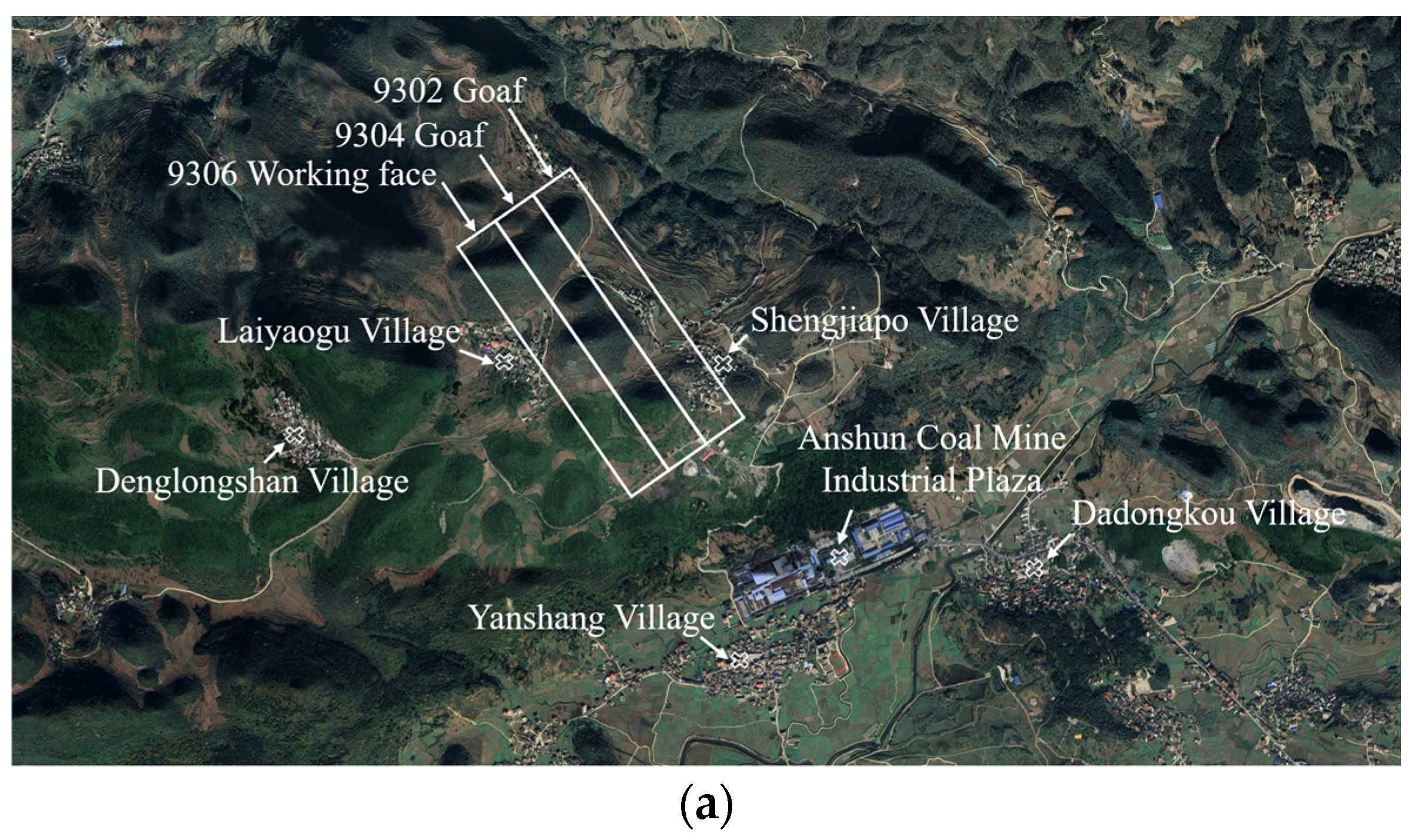


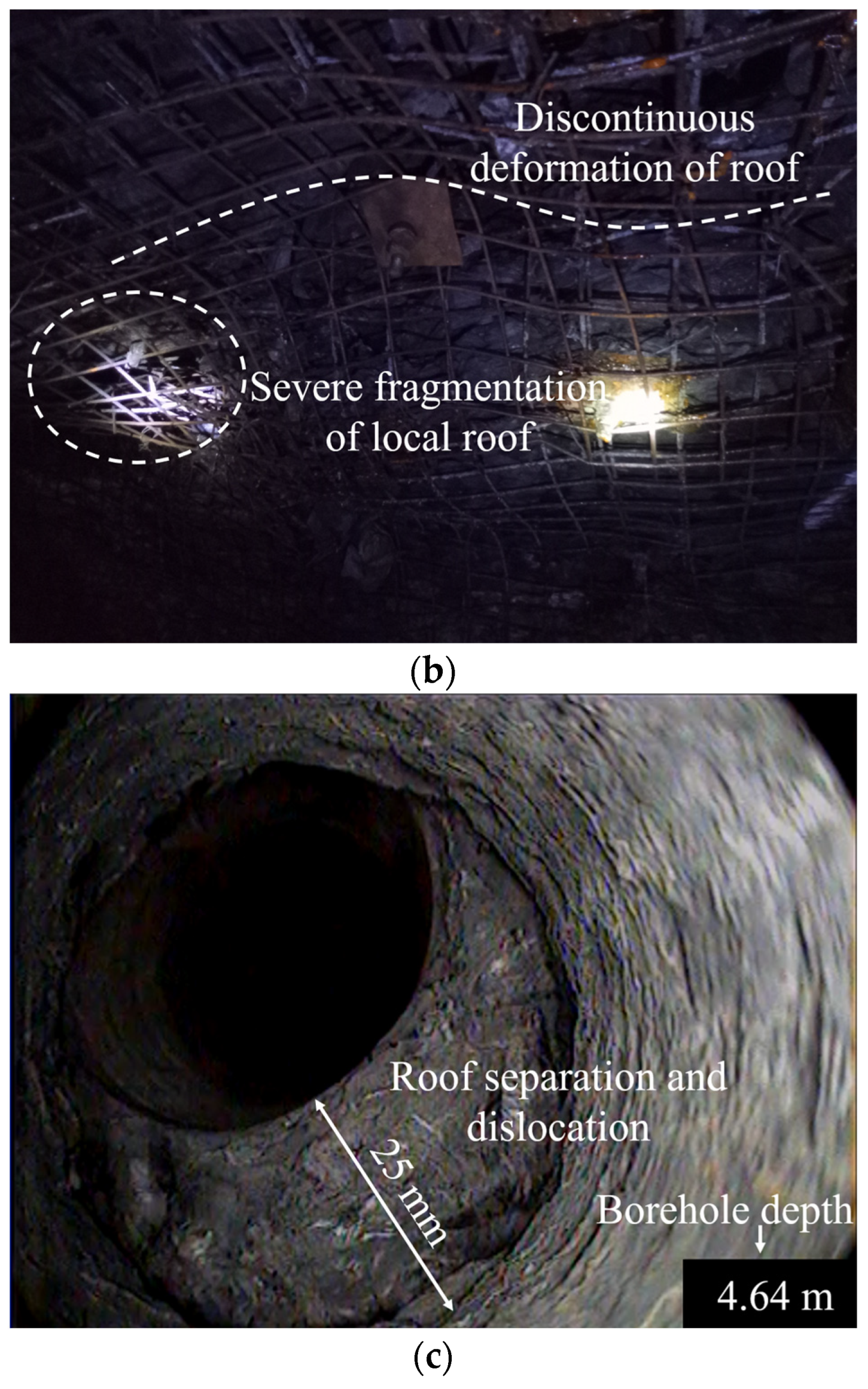
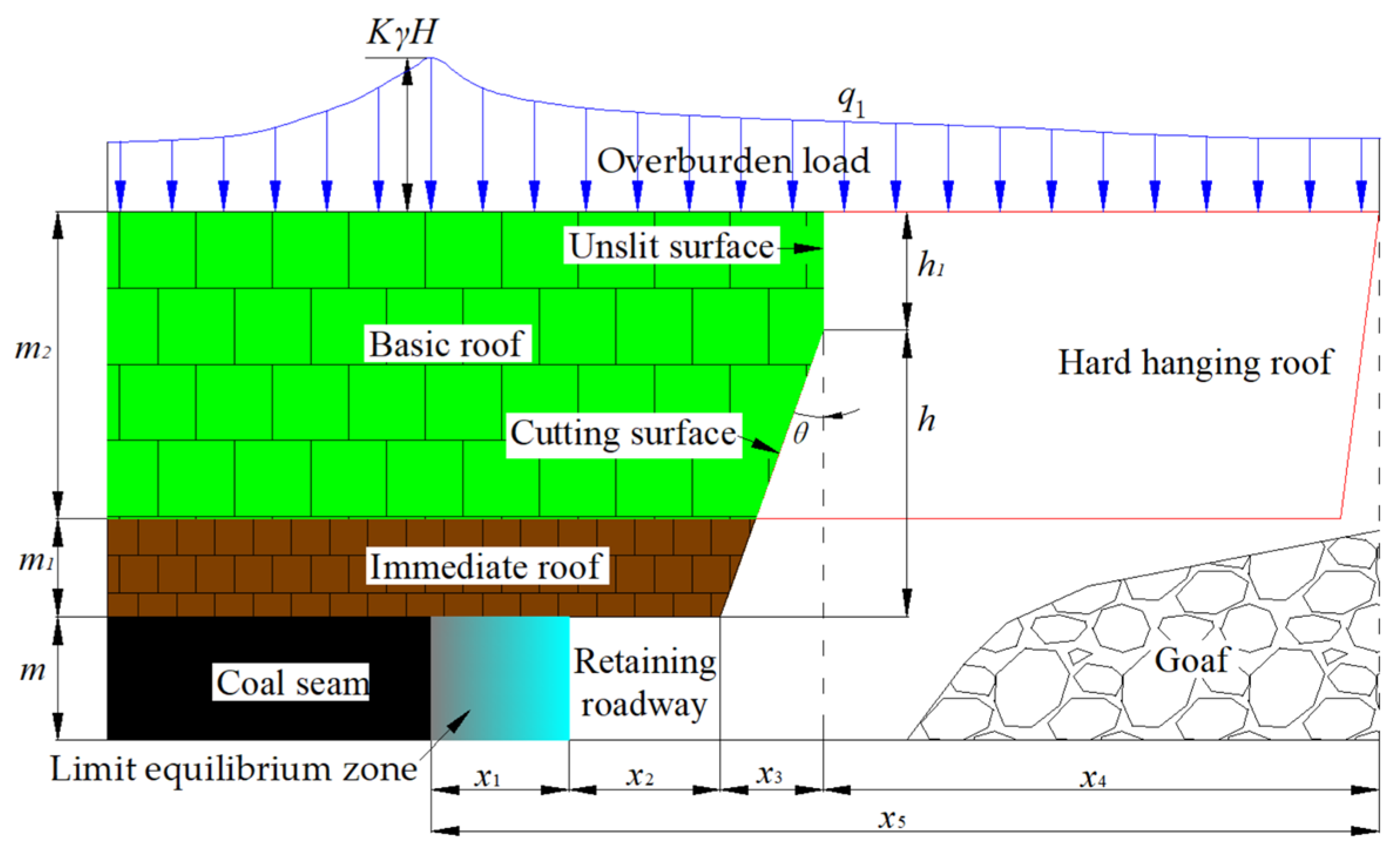

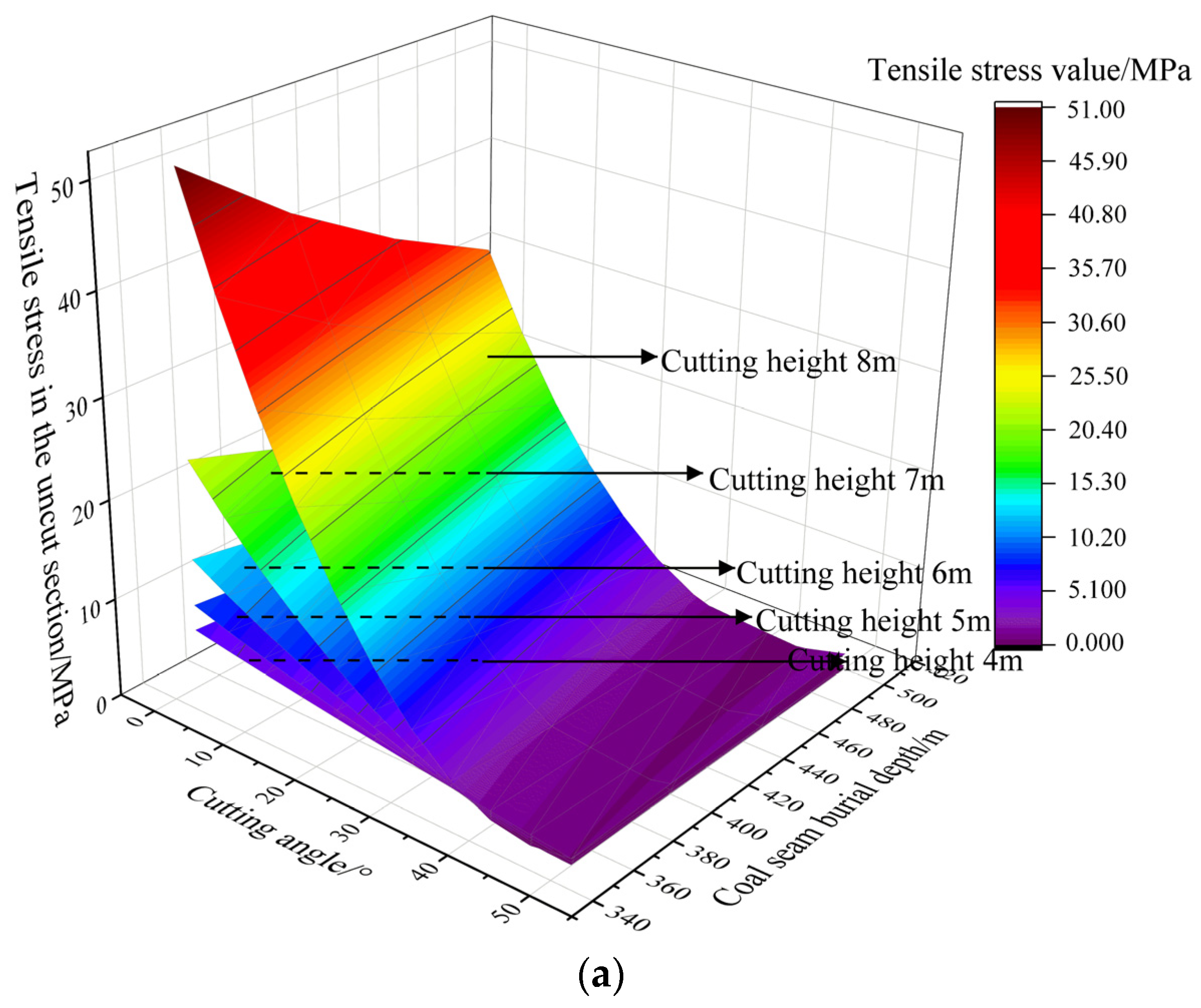






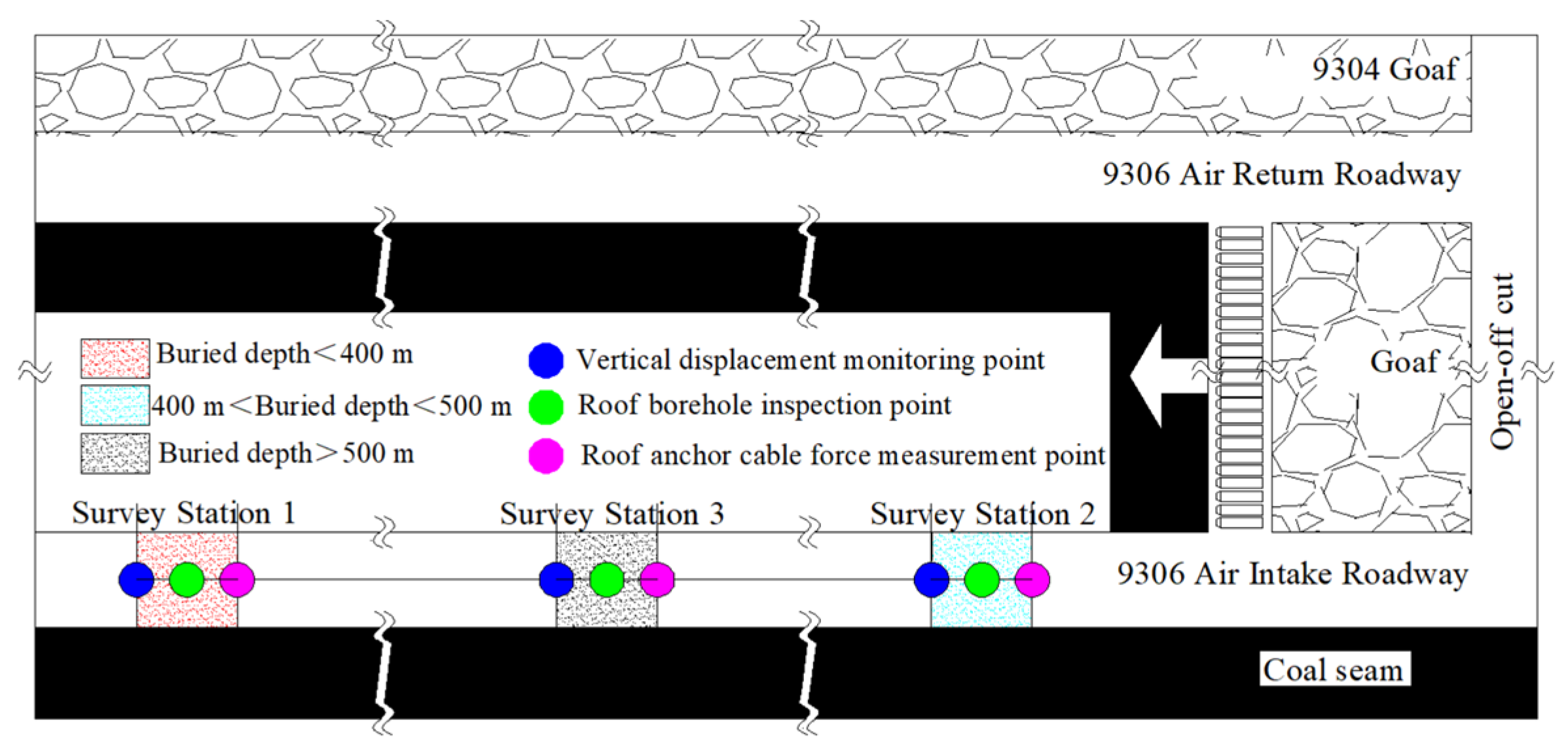
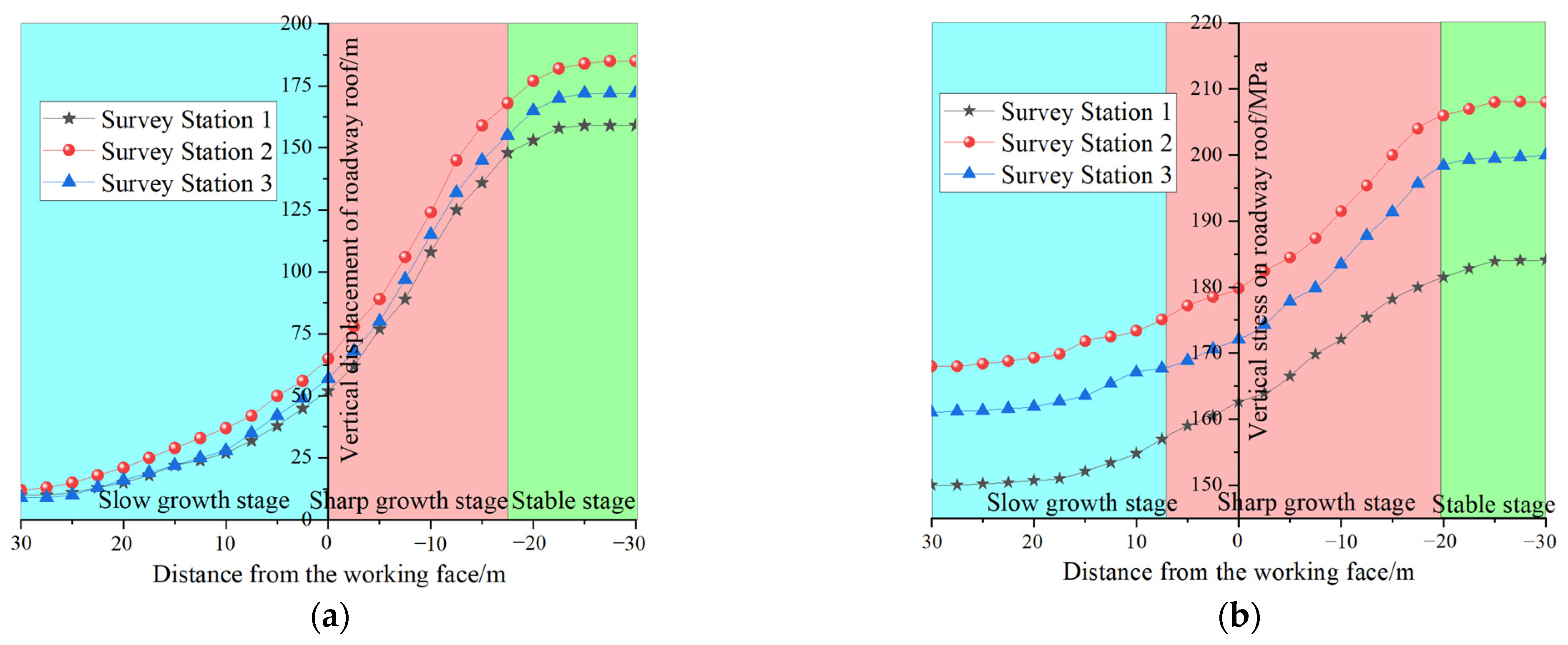
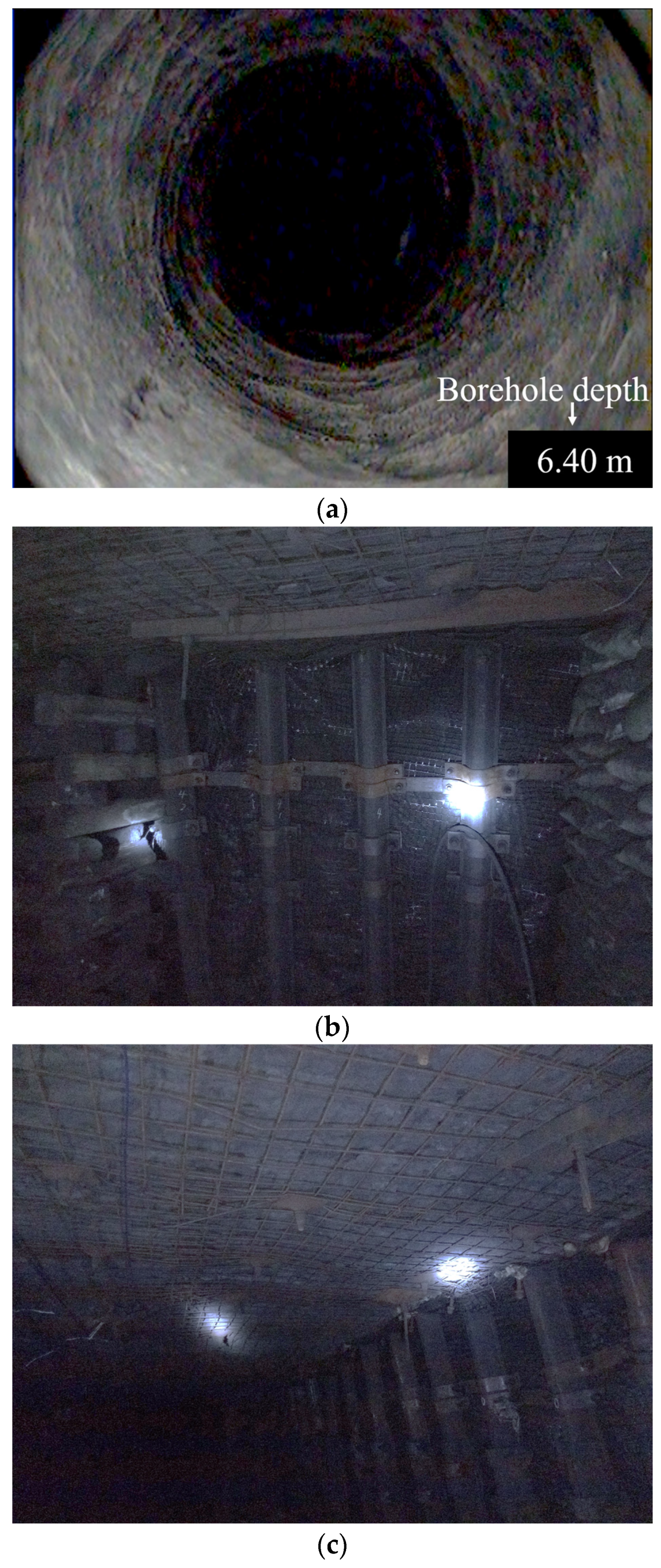
| Coal Seam Burial Depth/m | Fix the Cutting Height as an Integer | Fix the Cutting Angle as an Integer | ||
|---|---|---|---|---|
| Cutting Height/m | Cutting Angle/° | Cutting Angle/° | Cutting Height/m | |
| 450 | 5.5 | 0.9 | 0 | 5.4 |
| 6 | 6.8 | 5 | 5.8 | |
| 6.5 | 11.6 | 10 | 6.3 | |
| 7 | 15.8 | 15 | 6.9 | |
| 7.5 | 19.4 | 20 | 7.6 | |
| 8 | 22.7 | 25 | 8.4 | |
| / | / | 30 | 9.3 | |
| Numerical Simulation Scheme | Coal Seam Burial Depth/m | Cutting Height/m | Cutting Angle/° | Tensile Stress in the Uncut Part/MPa |
|---|---|---|---|---|
| Scheme 1 | 350~400 | 5 | 0 | 8.6~7.2 |
| Scheme 2 | 350~400 | 6 | 10 | 9.2~7.5 |
| Scheme 3 | 400~450 | 6 | 5 | 9.2~7.7 |
| Scheme 4 | 400~450 | 7 | 15 | 9.4~7.5 |
| Scheme 5 | 400~450 | 8 | 20 | 12.3~7.3 |
| Scheme 6 | 450~500 | 7 | 5 | 13.1~11.0 |
| Scheme 7 | 450~500 | 7 | 10 | 10.1~8.4 |
| Scheme 8 | 500~550 | 8 | 5 | 23.2~19.5 |
| Scheme 9 | 500~550 | 8 | 10 | 16.8~13.8 |
| Scheme 10 | 500~550 | 8 | 15 | 11.5~9.2 |
| Rock Strata | Bulk GPa | Shear GPa | Tensile MPa | Cohesion MPa | Friction (°) | Density Kg/m−3 |
|---|---|---|---|---|---|---|
| Limestone | 10.2 | 7.8 | 6.1 | 4.8 | 42 | 2700 |
| Siltstone | 8.5 | 6.4 | 5.5 | 3.4 | 30 | 2300 |
| Fine-grained sandstone | 12.1 | 8.5 | 7.5 | 5.2 | 35 | 2500 |
| Flint limestone | 11.0 | 8.1 | 7.2 | 5.0 | 42 | 2700 |
| Claystone | 1.4 | 1.6 | 1.8 | 1.9 | 23 | 1800 |
| Coal seam | 1.3 | 0.8 | 1.2 | 1.5 | 21 | 1400 |
| Clayey sandstone | 4.2 | 4.5 | 3.5 | 3.0 | 26 | 2200 |
| Silty claystone | 3.8 | 3.0 | 1.5 | 2.4 | 23 | 1900 |
| Numerical Simulation Scheme | Coal Seam Burial Depth/m | Cutting Height/m | Cutting Angle/° | Safety Factor of Roadway |
|---|---|---|---|---|
| Scheme 1 | 350~400 | 5 | 0 | 1.78 |
| Scheme 2 | 350~400 | 6 | 10 | 2.02 |
| Scheme 3 | 400~450 | 6 | 5 | 1.74 |
| Scheme 4 | 400~450 | 7 | 15 | 1.84 |
| Scheme 5 | 400~450 | 8 | 20 | 1.86 |
| Scheme 6 | 450~500 | 7 | 5 | 1.82 |
| Scheme 7 | 450~500 | 7 | 10 | 1.96 |
| Scheme 8 | 500~550 | 8 | 5 | 1.68 |
| Scheme 9 | 500~550 | 8 | 10 | 1.88 |
| Scheme 10 | 500~550 | 8 | 15 | 1.86 |
Disclaimer/Publisher’s Note: The statements, opinions and data contained in all publications are solely those of the individual author(s) and contributor(s) and not of MDPI and/or the editor(s). MDPI and/or the editor(s) disclaim responsibility for any injury to people or property resulting from any ideas, methods, instructions or products referred to in the content. |
© 2024 by the authors. Licensee MDPI, Basel, Switzerland. This article is an open access article distributed under the terms and conditions of the Creative Commons Attribution (CC BY) license (https://creativecommons.org/licenses/by/4.0/).
Share and Cite
Liu, Y.; Guo, W.; Fan, G.; Yu, W.; Chai, Y.; Yue, X.; Han, X. Research on Key Roof-Cutting Parameters for Surrounding Rock Stability Control in Gob-Side Entry Retention without Coal Pillars in Karst Mountainous Area. Appl. Sci. 2024, 14, 8118. https://doi.org/10.3390/app14188118
Liu Y, Guo W, Fan G, Yu W, Chai Y, Yue X, Han X. Research on Key Roof-Cutting Parameters for Surrounding Rock Stability Control in Gob-Side Entry Retention without Coal Pillars in Karst Mountainous Area. Applied Sciences. 2024; 14(18):8118. https://doi.org/10.3390/app14188118
Chicago/Turabian StyleLiu, Yutao, Wenhao Guo, Gangwei Fan, Wei Yu, Yujian Chai, Xin Yue, and Xuesen Han. 2024. "Research on Key Roof-Cutting Parameters for Surrounding Rock Stability Control in Gob-Side Entry Retention without Coal Pillars in Karst Mountainous Area" Applied Sciences 14, no. 18: 8118. https://doi.org/10.3390/app14188118
APA StyleLiu, Y., Guo, W., Fan, G., Yu, W., Chai, Y., Yue, X., & Han, X. (2024). Research on Key Roof-Cutting Parameters for Surrounding Rock Stability Control in Gob-Side Entry Retention without Coal Pillars in Karst Mountainous Area. Applied Sciences, 14(18), 8118. https://doi.org/10.3390/app14188118








